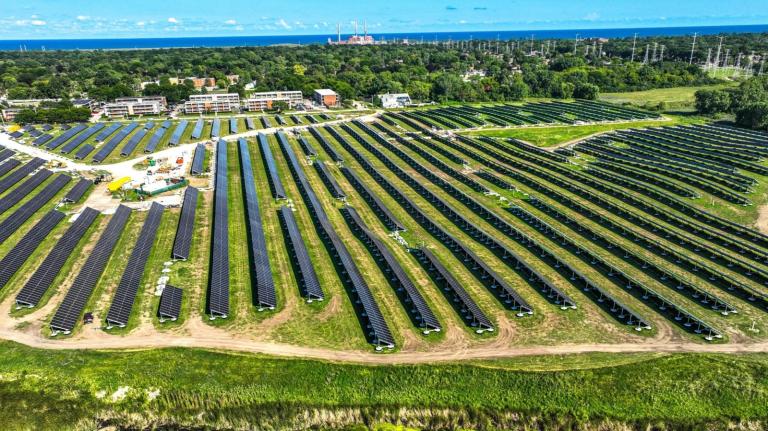This post originally appeared on Energy Self-Reliant States, a resource of the Institute for Local Self-Reliance’s New Rules Project.
A recent Colorado news story captures the tension between two visions of renewable energy, with a quote that illustrates the conventional wisdom:
“It’s not an either or choice, that we only put solar on rooftops or on people’s homes or do utility scale, large projects,” said Pete Maysmith, executive director of the Colorado Conservation Voters.
“As we move forward toward energy independence, reducing our dependence on foreign oil, on dirty, polluting sources of energy like coal, we need to move forward on all fronts with renewable [energy], and that includes rooftop solar and community solar gardens, local power. It also includes utility-scale solar that is properly sited, and that’s really important.”
On the contrary, we may have to choose.
Part of the choice has to do with the superiority of distributed generation. Most states have sufficient renewable resources to be self-sufficient, the relative costs of local generation aren’t much higher (especially when factoring in local economic benefits), distributed generation of wind and solar can use an abundance of spare capacity [PDF] on existing distribution grid infrastructure, often at a much lower cost than high-voltage transmission [PDF], and can scale up more quickly than centralized generation that relies on new transmission infrastructure.
But the choice also comes from the reality that financial resources are limited, the system of regulations and incentives are skewed toward big, centralized solutions, and choosing one strategy (long-distance transmission of centralized generation) necessarily reduces the money available and future prospects for expanded distributed generation.
The federal big energy gravy train
This dynamic is playing out at the Federal Energy Regulatory Commission (FERC), where the federal government is routinely providing utilities with bonuses to their return on equity for large-scale, high-voltage transmission projects. Since 2007, FERC has had 45 requests for bonus incentives for transmission development — authorized under the 2005 Energy Policy Act — and has provided all or most of the requested incentives in more than 80 percent of the cases. With the bonuses, the average return on equity for utilities for their new transmission investments is nearly 13 percent. This high rate of return is a full 2.5 percentage points higher than the median utility return on equity [PDF], a value considered just and reasonable by state public service commissions in ordinary times. However, these rewards came during a time when unemployment doubled, the stock market tumbled, and most corporations were lucky to have any profit.
The ratepayer impact of these bonuses is significant. In a November 2010 criticism of FERC transmission awards, Commissioner John Norris noted that the 2 percent bonus FERC provided to the PATH high-voltage project on the Eastern seaboard would “cost [Maryland] ratepayers in PJM at least $18 million per year.” The bonus payments were also given in concert with other incentives that reduced risk, including rate recovery during construction and guarantee of payment if the facilities were abandoned for reasons outside utility control.
While FERC asserts that it uses the bonuses to help incentivize the development of new transmission to improve reliability and reduce congestion, it doesn’t do its homework. Rather, FERC refuses to study more economical alternatives; doesn’t require the incentives to be necessary for the transmission development; and doesn’t even require that the proposed utility expenditures are prudent. Some great quotes [PDFs] from the horse’s mouth:
- “There is no requirement in section 219 or Order No. 679 that an applicant must demonstrate that its project is the best of all possible projects, or that it has explored every conceivable alternative before deciding to proceed with a particular project.”
- “We note that [American Electric Power] is under no obligation under either FPA section 205 or FPA section 219 to establish that the incentives requested are necessary.”
FERC also routinely hands out a 0.5 percent bonus incentive to every utility for participation in its respective regional transmission organization (RTO). This reward is given to every utility that asks for it, despite a Government Accountability Office report suggesting that the consumer benefits of such membership are unproven; and in one case, despite the fact that the requesting utility was already required by state law to participate in the RTO.
The most likely outcome of FERC’s lavish program for transmission development is a significant increase in utility shareholder profits at the expense of ratepayers, with only marginal improvements in the amount of available transmission capacity for new centralized renewable energy projects. The program may actually decrease utility interest in expanding transmission capacity, because offering them a higher ROE increases the total cost of new infrastructure, decreasing the demand for it and reducing investment.
When talking clean energy policy, it may sound inclusive to suggest that “we can do both” big, centralized and small-scale, decentralized renewable energy development. But money for clean energy is zero-sum. The millions of dollars FERC is expending to boost utility shareholder profits for new transmission development cannot be deployed as new distributed generation. Instead, the focus on centralized generation infrastructure creates a path dependency that can limit opportunities for distributed generation development.
That’s a bad deal, especially when there are signs that smaller generation gets bigger numbers of renewable energy projects online, faster. If we care about the urgency of climate change, and desire the biggest bang for the renewable energy buck, we may have to choose a path.
You can read more about these issues in the forthcoming report: “Democratizing the Electricity System,” coming June 22.




